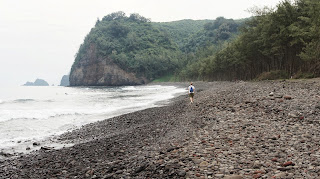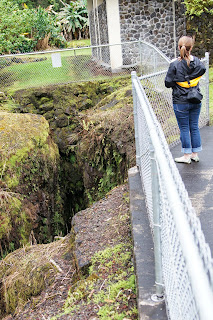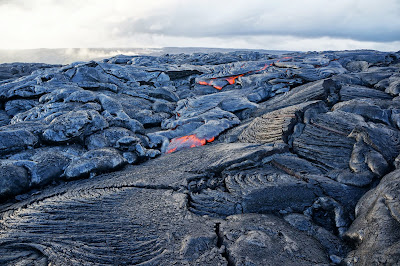Day 4: Westward, HO! (plus a stop or two)
Laura:
Before heading out for our next B&B, we had one last Papaya Boat
thanks to our great host, Gary. It's a strawberry papaya with the center
cleaned out, filled with yogurt and fruit, and decorated with the
cutest little critter face I've ever seen! Good show, Gary!
 |
| Our jungle home at the Volcano Tree House (2nd house owned by Bamboo Orchid Cottage B&B). |
The Green Sand Beach (Papalokea) is made from the ocean waves pummeling lava filled with olivine (when it's gem stone quality it's called peridot), which gives the beach it's khaki/olive green color - much easier to see in person than in our photos. They just don't do the color justice! There are only two green sand beaches in the world - the other is located on the Galapagos Islands. Guess we'll have to plan our trip to the Galapagos one day so we can say we've been to both!
 | |
| It's hard to appreciate the green sand from a distance. Wait for it.... |
 |
| Looks green, right?!? The sand was almost the same color as Alex's olive shorts and the ocean blue like his shirt, so we tried to take a "stealthy" picture with the water and sand. Tried.....lol! |

There were some pretty big waves rolling in with a significant undertow, so we didn't go swimming. But it was nice enough just to sit and enjoy the scenery!
After lounging around the beach for a while, we made the long journey back to South Point. Here are a few pictures from the southern-most point of the United States and nearby coastline!
From South Point, we continued north towards Captain Cook - the location of our next B&B. We stopped here and there to take in the stunning views from some road-side outlooks.
 |
| That's South Point in the background |
Finding our next B&B, the Aloha Guesthouse, was a little tricky. The driveway is tucked away off the main road and then there is a very steep and bumpy ride up a mountain side to get to the actual house, but again the crazy journey pays off big time! The Aloha Guesthouse is nestled amongst several coffee bean farms and fruit orchards, which gives it a nice jungle feeling, but it is high enough on the mountain that you get incredible views of the ocean below. Our room had giant windows facing the ocean, so we got to witness some great sunsets!
After meeting our new innkeepers, Lee & Svetlana, and getting settled, we headed out for dinner at a local restaurant - the Keei Cafe. There I had my first taste of pan-seared, fresh tuna - YUM! Better than steak! For dessert we ordered the lillikoi (passion fruit) cheesecake - also YUM!
Quick notes about our stay at this B&B - 1)You should definitley stay there! 2) Being younger travelers, we are usually the "odd couple" at B&B's that are often frequented by older, more low key travelers. However, we were happy to find several couples of the younger variety at the Aloha Guesthouse during our stay which made for a lot of fun breakfast conversations. Not sure if there are always younger people, but it was nice during our stay. 3) The breakfast....FANTASTIC! Svetlana is an excellent cook. She alternates sweet breakfast with savory each day which keeps things interesting. Everything we had was super delicious, fresh, and homemade. They even use fruit from their own land in their cooking! I could talk about the food all day, but sadly we must move on...
Day 5: Snorkeling and Learning
After a delicious breakfast, we began Day 5 with a brief walk around the Aloha Guesthouse checking out the natural flora & fauna and picking some fruit to snack on later in the day.
 |
| Walex picking "Ugly Fruit" from a nearby grove |
Then we decided to stay close to home and explored two really unique sites: Honaunau Bay & Place of Refuge. Honaunau Bay is an excellent place to go snorkeling or scuba diving. We started our day here and spent several hours checking out the local wildlife while swimming amongst the reef and rocks.
 |
| View of Place of Refuge from Honaunau Bay |
 All snorkeled-out, we headed to our second stop for the day - the Place of Refuge (Pu`uhonua O Hōnaunau). This national park is home to a very special piece of Hawaiian culture. In ancient Hawaiian culture there were many rules, or Kapu, that people were required to follow to help maintain order in society. A couple Kapu examples: Your shadow can never fall across the shadow of the king, you may never interrupt a chief while he is speaking, men's food couldn't be prepared in the same bowls as food for women, and many more! If you did break a kapu the penalty was death for you AND your entire family!!! However, there was one chance for you to escape this fate - run to a Place of Refuge. If you were able to make it to the Place of Refuge before the authorities caught you, then you were safe and could spend time at the refuge "repenting your sins" and eventually return to society with all forgiven. This rule also applied to defeated warriors - if a warrior from the losing tribe could make it to a Place of Refuge before the winning tribe caught him, then the defeated warrior was allowed to live. Pretty neat policy! You can read more about the history by clicking the link above.
All snorkeled-out, we headed to our second stop for the day - the Place of Refuge (Pu`uhonua O Hōnaunau). This national park is home to a very special piece of Hawaiian culture. In ancient Hawaiian culture there were many rules, or Kapu, that people were required to follow to help maintain order in society. A couple Kapu examples: Your shadow can never fall across the shadow of the king, you may never interrupt a chief while he is speaking, men's food couldn't be prepared in the same bowls as food for women, and many more! If you did break a kapu the penalty was death for you AND your entire family!!! However, there was one chance for you to escape this fate - run to a Place of Refuge. If you were able to make it to the Place of Refuge before the authorities caught you, then you were safe and could spend time at the refuge "repenting your sins" and eventually return to society with all forgiven. This rule also applied to defeated warriors - if a warrior from the losing tribe could make it to a Place of Refuge before the winning tribe caught him, then the defeated warrior was allowed to live. Pretty neat policy! You can read more about the history by clicking the link above. This Place of Refuge on the Big Island is one of the best preserved examples in Hawaii. There are a handful of ancient artifacts and structures to check out and a lot of history to learn. It was a great way to spend our afternoon - stroll through the gorgeous park, learn a little history, and take in the beautiful views along the coast line. If you're lucky you may even spot a couple dolphins or sea turtles!
 |
| Only true professionals know when to bust out the Gorilla-Pod! ;0) |
With our brains filled with fun facts about ancient Hawaiian culture, we headed up the coast to check out Kona. Kona is a very large and touristy city. We attempted to find a place to eat dinner, but everything was way too crowded and kind of a culture shock compared to the smaller towns we'd been visiting thus far. SO MANY PEOPLE!!! Maybe we'll go back there one day and stay at a fancy resort, but for this trip it was just too much to handle. We headed back towards Captain Cook and stopped at Teshima's Restaurant for some authentic Japanese cuisine. You've gotta try the tempura dinner and chocolate mousse dessert!
Day 6: To the end of the road...
 |
| No pics of the beach, but here's a nice shot of Laura with her outfit matching some flowers |
Day 6 was a huge travel day! Based on suggestions from our innkeepers, we spent this day driving up to the northern tip of the Big Island and made several pit stops along the way. First we stopped at "Beach 69", aka Waialea Bay, for a late morning beach break. There are a lot of big trees along this beach which creates excellent shade for pale people like me to hang out in and that morning there was great surf rolling so there were plenty of waves for Alex to romp in! It's a more secluded beach compared to Hapuna Beach just to the north, so we had a nice calm atmosphere with few people to bug us. Definitely a great spot to stop for a couple of hours!
From Beach 69 we continued north along the coast through some very interesting, desert-like terrain in areas that are slowly recovering from lava flows in the 1800s. Such a huge contrast from the lush greenery further south in Captain Cook and the rainforests back on the east-side in Hilo.
Our next stop was Hawi (Ha-vee, in the Hawaiian language w = v), a small town on the northern coast that is home to many artists and a really great place to stop for lunch: The Bamboo Restaurant & Gallery. They serve delicious food and the Lillikoi Iced Tea is to die for! You can even purchase a bottle of their Lillikoi drink mixer to take home! There is also a small gallery/souvenir shop attached to the restaurant for those of us who like to buy little trinkets to take home.
Beyond Hawi, Highway 270 dead-ends just above Pololu Beach. There is a small parking area that gives great views of the beach and the mountains surrounding the Pololu and Honokane Nui Valleys, which look like something out of the opening credits for Jurassic Park!
 |
| Pololu Beach down below... |
 |
| ...and Jurassic Park off in the distance! |
As I mentioned the road ends just ABOVE the beach, so we made the 20-30 minute trek down the cliff-side on a steep and rocky trail with lots of switchbacks. The further down we went the more we realised how much we'd hate the hike back up, but getting to the beach was definitely worth the hardship.
Pololu Beach is a black sand beach mixed with a large assortment of stones smoothed down by the crashing waves that make perfect skipping stones! We spent a lot of time working on our skipping skills. I think I have made some improvement, but there is still a long way to go!
 |
| Back at the top! So exhausted and sweaty, but so worth it! |
Once we successful completed the epic climb back up to our car, we packed up and headed home!
Day 7: One final journey...
Alex: We had to get back to the real world someday, but on our return trip we decided we would take the scenic route along the Saddle Road. Before we hit the road, we said goodbye to the Aloha Guest House.
 |
| The Innkeepers were harvesting fruit when we left. Here's a bunch of miniature bananas freshly picked. |
The Saddle Road travels right across the middle of the island, between the two big peaks of Mauna Loa and Mauna Kea. Someday I'd like to take the road up to the observatory on Mauna Kea, but we didn't have time this time. It was neat to start at sea level, and then an hour later be over a mile up driving right alongside Mauna Kea rising two more miles up into the clouds.
The terrain changes along the drive were pretty impressive. We attempted to take some pictures regularly during the drive and compiled a gif below. Over the course of a couple hours we passed from jungle to lava flow to scrub land to forest to desert to grassland to fog-covered unknown and back into jungle again.
Laura: When it was all said and done, we returned our Jeep with nearly 800 miles under our belts. Not too shabby for seven days on the Big Island. We'll have to return someday to hit the northeast corner where all the cowboys live. Until next time!...
~The Lorax~
















































































































